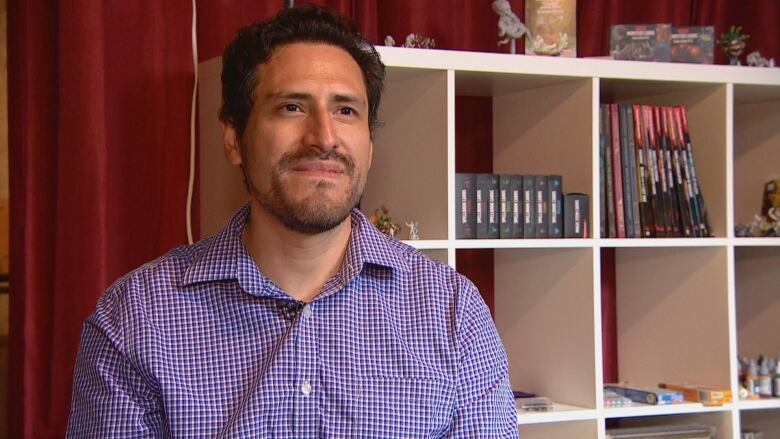
[ad_1]
Five players sit around a large table scattered with paper, pens and an electronic game board, with a colourful rug beneath them. Salmond ensures each person has dice, miniatures and a completed character sheet — all important components for a successful Dungeons & Dragons game. The pizza and beer don’t hurt, either.
After reviewing the rules, Salmond begins to describe the scene.
“We start our adventure in the warmth of the Yawning Portal Inn. Five unlikely friends find themselves, as they say, in the right place at the wrong time,” she says.
It goes on for a few minutes. Occasionally, the players let out oohs and ahhs at the details of their newfound world. Then, the game begins.
Scenes like this are playing out increasingly often as the 1974 role-playing game sees a resurgence in popularity.

Players and fans of the game point to several reasons why: a more exciting and inclusive fifth edition, a craving for connection following the pandemic and a starring role in the popular TV series Stranger Things. The show’s main characters are often seen playing the game.
“People were hearing about it more, but I think that there are tools, especially virtually, that have really been well developed in the last few years … it’s a little bit more accessible,” Salmond said.
“What I like about D&D is the creativity. I love being able to improv scenarios and explore story lines and characters, and my other favourite part of it would probably be the laughs.”
Gordon Johansen, owner of The Sentry Box, a Calgary gaming store, says the game itself has also become more inclusive.
He has worked in the industry for 42 years, and in his opinion, more women than ever before are playing D&D.
“Fifth edition kind of went back to the roots … really re-emphasized the storytelling aspect and the actual role-playing,” he said.
“They simplified some stuff, made it much more appealing to women … who just didn’t want to play the old super competitive group.”

Some friends invited Heidi Pedersen to play the game for the first time in December. Over the past few months, she’s grown to enjoy it.
“It exceeded every expectation that I had,” she said.
“It’s a lot of fun, to be honest.… I think there has been more of a general acceptance and perhaps celebration of being a full-on nerd.”
How it works
But of course, the enjoyment for Pedersen came after figuring out how to actually play the game.
Basically, D&D is a role-playing game where people go on quests while developing their own characters. A dungeon master, like Salmond, leads the game. They’re in charge of describing scenarios, guiding the group and enforcing the rules.
“It’s important to play to your own strengths, whether that’s doing voices or having really inventive storylines or maybe just adapting a pre-made adventure really well,” Salmond said.

Games can last for hours, weeks or in one case for Salmond, two years.
“Unlike a movie where the story ends after two hours, you know that your story is going to keep going and you get to explore more of it the next session,” she said.
“I think that’s really exciting and engaging and makes me want to keep coming back for more.”
For the most part, the game doesn’t require a ton of stuff. Players need some dice, game sheets, pens and paper, a rulebook and most importantly, an active imagination.
‘A nice escape’
Although the game is attracting new players, Johansen says interest in the imaginary world has never really wavered.
Before the pandemic, he sold $17,000 in D&D dice every month on average. In the game, dice are used for different actions. They come in different, sometimes time-limited colours, so they’ve become something of a collectible, he says.

When people began to play more online, those sales dropped off. In their place, miniature purchases shot up. Those are small figurines used to represent people in the game, and many people began to paint their own in isolation.
Now that most people are back in-person, Johansen says general interest is ramping back up.
“We’ve now got the second generation of people who’ve come back who remembered … playing it as a kid and went, ‘that was a lot of fun.’ And now I’ve got kids and I want to do something with them.”
Others like Miguel Ayandgui had always heard about D&D but preferred video games. With the encouragement of friends, he began playing the game recently.
“The role-playing was something that I’d never really tried as much. So I thought that was pretty neat,” he said.
“It really is a nice escape in that regard. Like it lets you be a character and live a different life or adventure.”

And an adventure he got, back around the basement table. His character, an elf fighter, may come in handy as the group faces a tricky predicament.
One of the characters lost a spontaneous arm wrestle, attracting some unwanted attention.
Leafing through the players’ handbook, they discuss how they might approach the scenario. It required some lucky rolls and a bit of creativity, but eventually, the situation passed.
If it all sounds intriguing but confusing, it’s worth giving the game a try, Pedersen says.
“I think it gives us all a chance to kind of explore. That’s a huge one, to play.… It gives us a chance to kind of navigate things in a different way,” she said.
“It’s pretty close to free therapy, in my opinion.”
[ad_2]

التعليقات